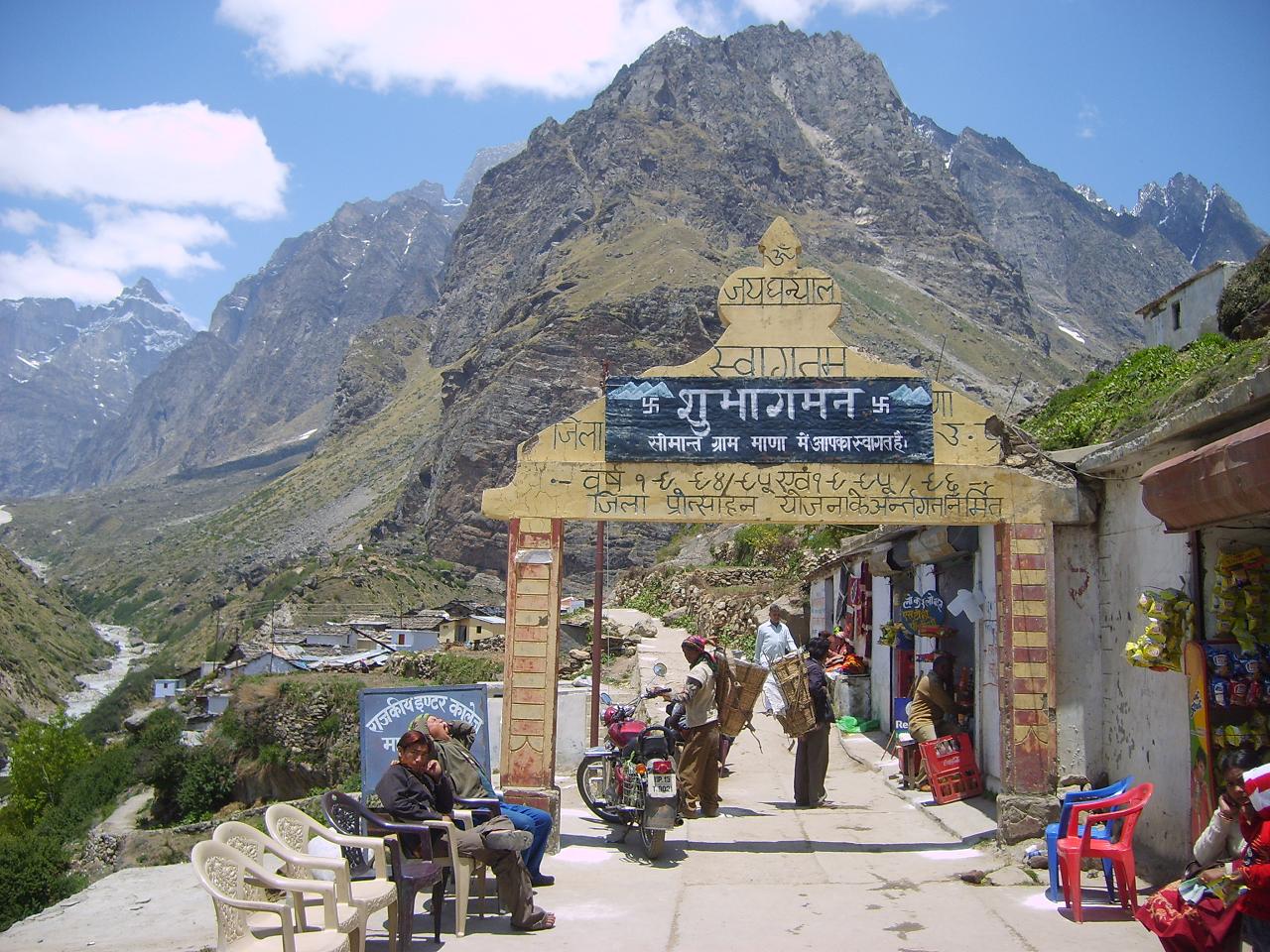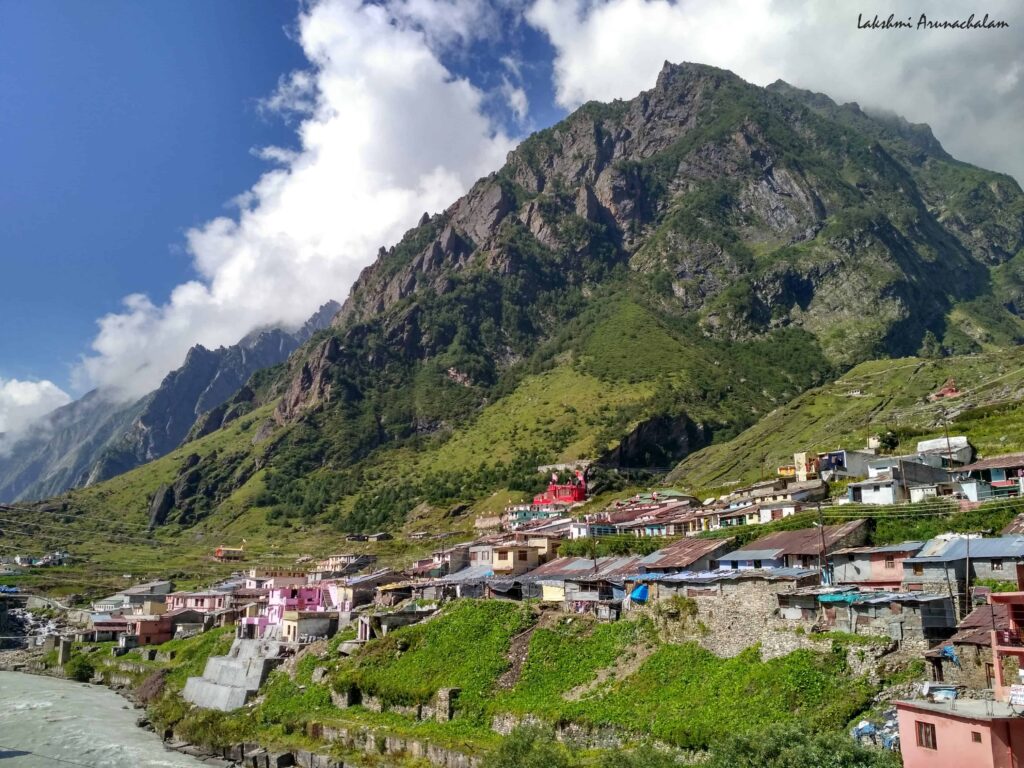
Mana is the last village in India on the border with South Tibet. It is located three kilometres away from the holy dham of Badrinath at a height of 3219 meters above sea level in the Indian state of Uttarakhand. Mana is equally holy as Badrinath. It is home to the Vyasa Gufa, Ganesha Gufa and Bhim Pul. The sacred river Saraswati originates here.

The state government has declared Mana as a tourism village and a heritage village. It was also awarded as the ‘most clean, iconic tourist destination’ under the Swachh Bharat Mission (Rural) in 2019. The pristine beauty of Mana village enveloped by the mystical Himalayas enhances the spiritual vibration of the village. The fresh and clean air here amplifies your devotional aspirations. The sweet and calm villagers will blossom your heart.
Mani is the entrance point of Satopanth Swargarohini Yatra – a route which was undertaken by the Pandavas at the end of their life.
Vedic History of Mana
Mana’s tryst with history was 5000 years ago when the Pandavas passed through Mana on their way to Satopanth Swargarohini from where they ascended to heaven. It was during this journey that they had to cross the Saraswati river here. Bhima, one of the Pancha Pandavas lifted and placed a huge rock over the Saraswati river so that Draupadi Devi could cross the river. This bridge made by Bhima is still present in Mana.

The ancient name of Mana is Manibhadrapuri. It was the residence of Ghanta Karna, a great devotee of Lord Shiva. Ghanta Karna would move around with bells in his ears so that he could avoid hearing the name of Lord Narayana. Once he performed tapasya to please Lord Shiva to gain liberation.
Pleased by his tapasya, Lord Shiva gave him darshan and informed him that mukti could be granted only by Lord Narayana and that he should go to Badrinath to please Him. Although Ghanta Karna was surprised to hear this, nonetheless he achieved Lord Narayana’s favor at Mana. Lord Narayana appointed Ghanta Karna as the Kshetra Palaka of Badrinath Kshetra.
Holy Places in Mana
Mana, though a small village on the Indo-Tibet border, hosts a few sacred sites. These sacred sites make Mana a sacred village. They are as follows –
Vyasa Gufa: It is the sacred cave where Srila Vyasadeva sat and compiled the Mahabharata. The 18 Puranas too were compiled here by Srila Vyasadeva. It is also called as Vyasa Pothi as it appears like a stacked set of literature written on palm leaves. You have to climb 100 steps to reach the Vyasa Gufa.
Ganesha Gufa: Located near the Vyasa Gufa, Lord Ganesha sat in this cave and wrote down the Mahabharata on hearing the dictation of Srila Vyasadeva. He had even broken his own tusk to be used as a pen when his pen broke while writing down the Mahabharata.
Bhim Pul: It is the bridge made by Bhima, the Pandava brother to help his wife Draupadi Devi cross the Saraswati river. A 20 ft high marking on a rock nearby is said to be the footprint of Bhima.
Saraswati River: The sacred Saraswati river flows through the scenic village of Mana. It is said that the sound of the flowing Saraswati irritated Vyasadeva as He could not focus on the Mahabharata work. Hence, He cursed the river to flow hidden from the surface. To date, the sacred Saraswati has kept the Sage’s curse.
Mata Murti Temple: This temple is dedicated to the mother of Lord Nara-Narayana. Mata Murti had desired that Lord Vishnu should take birth as her son. Lord Vishnu granted her this desire and took birth as the twins Nara and Narayana. The annual mela in August every year sees a lot of people visiting this temple.
Tapt Kund: This Kund is the abode of Agnideva i.e. Fire God. Taking a dip in this Kund formed from a natural spring is said to cure skin diseases.
Vasudhara Falls: These falls lie on the path to the Satopanth Valley in Uttarakhand. It is said that the waters of these falls do not touch the body of a sinner. The Pandavas had gone through this route on their way to Satopanth Swargarohini. Sahadeva, the Pandava brother had given up his body near these falls.
Best time to visit Mana
The time-period between September to October is the best time to visit Mana. Entry of citizens from November to May is restricted. Though there are no restrictions on visiting the village during the other months, it is covered with rain and snow. It is recommended that the month of August be avoided to stay away from the heavy rains that lash this village. In such a scenario, it would not be possible to visit the holy places in Mana.
How to Reach Mana
If you wish to visit Mana and experience its spiritual vibrations along with the pristine beauty of the Himalayas, you will not find anything better than the Char Dham Yatra or the Badrinath Yatra conducted by Tirtha Yatra. You’ll keep the experience in your heart your entire life!
If you reach the holy dham of Badrinath, Mana is a stone’s throw away. You can utilize the following modes of transportation to reach Mana –
By Road: Badrinath is well connected to cities in Uttarakhand via bus services and taxis. You can get direct buses or taxis from Dehradun, Haridwar, Rishikesh, etc. From cities outside Uttarakhand, you can reach cities like Dehradun or Haridwar and then catch a taxi or bus for the journey forward to Badrinath.
There are regular buses from ISBT, Kashmiri Gate, New Delhi to Dehradun and onto Badrinath thereafter.
By Rail: The nearest railway station is at Rishikesh 289 kms away. You can board a train to Rishikesh Railway Station (RKSH) and then board a bus or hire a taxi to Badrinath from Rishikesh. If you are traveling to Badrinath from other cities in Uttarakhand by rail, you can adopt the same procedure.
By Air: Jolly Grant International Airport at Dehradun is the nearest airport 306 kms away. You can fly in here and use the rail or road route to reach Badrinath.
Helicopter services are available from Dehradun to Badrinath.
2











2 Comments On Mana Village
M Saiprasad
A very good information.
Excellent information. அருமையான தகவல்.